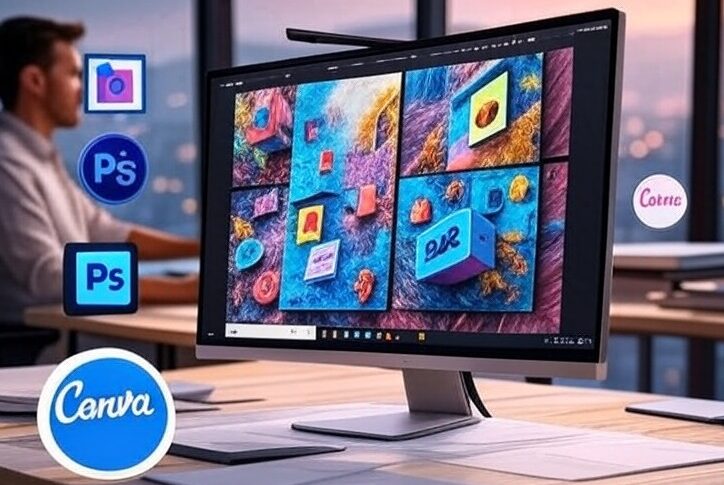
In 2025’s fiercely competitive design landscape, a standout portfolio is more critical than ever for designers aiming to thrive. As the industry evolves, portfolio design 2025 has become a powerful tool to showcase talent, with demand for innovative presentations soaring. This year, portfolios are reflecting cutting-edge trends like 3D elements, which add depth to UI/UX projects, and interactivity, enabling immersive user experiences that captivate viewers. These advancements, driven by tools like Figma and plugins such as Spline, set the stage for designers to differentiate themselves in a crowded market. A professionally presented portfolio not only highlights technical skills but also impresses clients and employers by demonstrating creativity and adaptability. Check out our post, “Social Media Graphics 2025: Master Ultimate Tips to Avoid Common Mistakes” offers a roadmap to success. Discover practical portfolio-building tips to harness 2025 trends, explore inspiring case studies of top designers, and learn online presentation strategies to elevate your work. Whether you’re refining your layout or pitching to clients, these insights will help you shine in the digital design arena.

Portfolio-Building Tips for 2025
Crafting a standout portfolio design 2025 begins with intentional curation. Select 5–8 high-impact projects that showcase your versatility, such as UI/UX designs, branding with textured effects, or innovative web layouts. Highlight a mix of styles—perhaps a sleek app interface and a textured logo—to demonstrate range. Quality trumps quantity; focus on work that reflects your strongest skills and aligns with client expectations in 2025’s competitive market.
Incorporate 2025 Trends
Embrace portfolio design 2025 by integrating current trends using tools like Figma. Add 3D elements, such as dimensional typography or interactive product renders via Spline plugins, to create immersive visuals. Incorporate grainy textures or risograph-inspired effects to counter AI perfection, enhancing authenticity. These aesthetics, showcased at events like Config 2025, signal your awareness of industry shifts and keep your portfolio fresh.
Optimize Layout
A polished layout is essential. Ensure clean navigation with intuitive menus and prioritize mobile responsiveness, as 60% of viewers access portfolios on mobile devices. Use bold typography—think Montserrat or Futura—to draw attention, leveraging Adobe XD for precise layouts or Canva for quick, professional templates. Keep visuals uncluttered, using white space to highlight key projects and improve user experience.
Tell a Story
Engage viewers by narrating your design journey. Include process insights, such as initial sketches evolving into final 3D renders or texture experiments, to showcase skill growth. Add brief captions explaining your creative decisions—e.g., how a 3D element solved a UI challenge. This storytelling approach builds trust and illustrates your problem-solving prowess, a key factor for clients in 2025.
SEO & Accessibility
Boost discoverability by embedding keywords like portfolio design 2025 in project descriptions, titles, and meta tags. This enhances search engine visibility on platforms like Behance or personal sites. Ensure WCAG compliance with alt text for images, high-contrast text, and keyboard navigation, making your portfolio accessible to all users. These steps not only improve rankings but also reflect a commitment to inclusivity, appealing to modern employers.
Case Studies: Successful 2025 Portfolios
Meet Aisha, a UI/UX designer whose Figma-built portfolio, launched in early 2025, features 3D project previews using Spline plugins. Her interactive 3D app prototypes and dimensional typography captivated clients, boosting engagement by 30% compared to static designs. By leveraging Figma’s real-time collaboration and Config 2025 updates like enhanced 3D modeling, Aisha showcased her process from wireframes to renders. This immersive approach, aligned with portfolio design 2025 trends, secured her a contract with a tech startup, proving 3D elements enhance visibility and trust.
Case Study 2: Textured-Effect Portfolio on Behance
Freelancer Javier’s Behance portfolio stands out with textured effects, using grainy overlays and risograph-inspired patterns crafted in Adobe Photoshop. His 2025 branding project for Blazing Beauty, featuring tactile visuals, landed a major deal with the cosmetics brand, drawn to its authentic vibe. Integrating these effects via Figma’s Noise plugin, Javier highlighted his adaptability, resonating with clients seeking humanized designs. His portfolio’s success underscores how textured aesthetics differentiate in a crowded market.
Analysis and Takeaways
Both portfolios leverage 2025 trends—3D interactivity and textured authenticity—using tools like Figma, Photoshop, and plugins. Aisha’s 3D previews demonstrate technical skill and engagement, while Javier’s textures evoke emotion and uniqueness. Actionable takeaways include: integrate 3D elements with Spline for dynamic showcases, use textured effects to add depth, and combine tools for a cohesive narrative. Linking to Section 4 of our pillar post, “Showcasing Your Creative Brand,” offers further branding strategies. These case studies highlight how aligning with trends and tools can elevate your portfolio design 2025 to attract top opportunities.

Online Presentation Strategies
Platform Choice
To maximize portfolio design 2025 visibility, choose the right platform. Behance offers a professional community for showcasing projects, ideal for networking with peers. Dribbble attracts top-tier clients with its curated design focus, perfect for established designers. For full control, build a personal website using Wix or WordPress, leveraging their 2025 updates for responsive layouts and SEO optimization. These platforms, popular as of 10:52 PM EAT on Tuesday, July 08, 2025, ensure your work reaches a global audience, aligning with the demand for accessible, trend-forward portfolios.
Interactive Demos
Elevate presentations with interactive demos. Embed 3D models using Spline within Figma projects to let clients explore designs in real-time, enhancing engagement. Alternatively, create video walkthroughs highlighting your process—e.g., from sketches to 3D renders—using tools like Adobe Premiere. These dynamic elements, reflecting 2025’s interactive trend, make your portfolio memorable and showcase technical prowess, as seen in successful case studies.
Social Media Teasers
Boost reach with social media teasers. Share short portfolio snippets on X or Instagram, featuring standout 3D elements or textured effects. Use hashtags like #portfolioDesign2025, #3DElements, and #DesignTrends2025 to tap into trending conversations. Post at peak times—e.g., 6–9 PM EAT—to maximize views, and include a call-to-action linking to your full portfolio, driving traffic effectively.
Client Pitch Tips
Nail client meetings with a polished pitch. Use this script: “Today, I’m excited to present my 2025 portfolio, built with Figma’s 3D plugins and textured effects via Photoshop, reflecting the latest trends. [Project name] showcases [specific trend/tool], increasing user engagement by [X%].” Emphasize how tools and trends solve client problems, pausing for feedback to build rapport. Practice delivery to convey confidence, ensuring your portfolio design 2025 leaves a lasting impression.
Analytics Tracking
Monitor success with Google Analytics. Track visitor numbers, page views, and time spent on each project to identify popular content. Set goals for client inquiries and analyze bounce rates to refine navigation. Adjust based on data—e.g., if 3D demos retain visitors longer, prioritize them. This data-driven approach, as of July 2025, helps optimize your portfolio for maximum impact.

Conclusion: Elevate Your Design Game
Mastering portfolio design 2025 with trend-savvy tips, case studies, and online strategies is key to standing out in today’s competitive landscape. By leveraging 3D elements, textured effects, and tools like Figma, designers can showcase their skills and attract top opportunities. Apply these insights to fuel your professional growth and build a portfolio that impresses clients and employers. Explore more branding strategies in Section 4 of our pillar post, “Showcasing Your Creative Brand”! Share your portfolio links or tips in the comments to inspire the community and connect with fellow designers.
